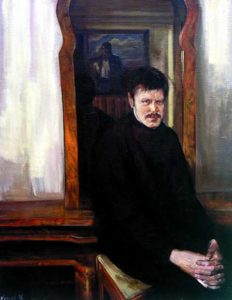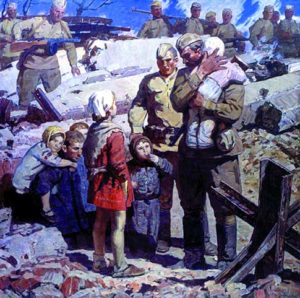
A new exhibit in the FGCU Library Archives offers a visual testament to one man’s passion to preserve his homeland’s cultural past as well as a historical record of shifting political ideologies in a region still rocked by conflict today.
“Україна: Ukraine — The Maniichuk-Brady Collection of Socialist Realist Art” features 20 paintings from about 150 that the late Jurii Maniichuk purchased in the wake of the 1991 demise of the Soviet Union. The Communist government-sanctioned artworks — idealized scenes of work life and military service as well as landscapes and still lifes — were discredited and in danger of being buried or destroyed in the post-Stalin era. Most of the works on exhibit date from the 1950s through the 1980s and were intended for public spaces – usually subject to official approval by cultural ministers.
The exhibit will be displayed through Dec. 3 in Library Room 322. Viewing hours are 9 a.m.-5 p.m. Monday-Friday.
A lawyer who loved the arts, Maniichuk amassed his collection while living and working in the 1990s in Ukraine, the republic where he was born and raised. Consulting experts from Ukrainian museums, he tracked down the leading masters of the socialist realist era.
“It really is a museum-quality collection,” says his widow, Rose Brady, a writer and editor based in Naples. “My husband always felt this art was great art even if some of the original intent was party propaganda to show the happy and glorious side of Soviet life. It evolved over the decades. These artists were highly trained. They were supported by the state. They received the best education in classical European art. Over the years, their art evolved to have their own voices come through.
“Jurii saw this art as a window on his past, on his own culture and his country’s soul.”

A longtime senior editor for Bloomberg Businessweek, Brady was the magazine’s Moscow bureau chief from 1989 to 1993, covering the end of the Cold War and of the Soviet Union. She has a doctorate in political science from St. Petersburg State University in Russia, a master’s in international relations from the London School of Economics and Political Science and a bachelor’s degree in English from Yale University.
Brady married Maniichuk in 2000. He had moved to Canada in 1991 and then to the United States, where he became a citizen while working as a legal specialist for the Library of Congress. In 1993, two years after Ukraine gained independence, Maniichuk felt compelled to return and help his homeland, Brady says; he worked as a legal consultant to the Ukrainian parliament and presidential administration for the U.S. Agency for International Development and the World Bank.
Maniichuk returned stateside with his collection in 1999. He died unexpectedly in 2009 while visiting Ukraine.
In the years before his death, Maniichuk and Brady tried to find a permanent home for the collection, which contains many large canvases. The fourth floor of the Ukrainian Institute of America in New York City displays a permanent rotating exhibit of a dozen or so works, but additional paintings in storage elsewhere have never been exhibited.
“My husband’s goal was for the collection to be brought to this country to be appreciated by the public,” Brady says. “I’m thrilled that FGCU is presenting this exhibit.”
The Maniichuk-Brady Collection can be studied from several perspectives, she points out. Art students can learn about an important period in Eastern European art and classical painting techniques. Journalism and history majors can explore past ideological movements in relation to current conflicts in the Ukraine, and museum studies students can learn about preserving and conserving art.
Anica Sturdivant, coordinator for The Art Galleries of FGCU, worked with Brady and Melissa Minds VandeBurgt, Archives, Special Collections and Digital Initiatives librarian, to arrange the exhibit. She calls the collection “vast and important.”
“We are fortunate to have on exhibit examples from this historical collection,” Sturdivant says. “These works are perspectives into history and political and philosophical trends of their day. The Soviet Union competed fiercely for dominance in science, industrial growth, politics and the arts in order to prove the superiority of communist doctrine. State institutions, like the Academy of Art USSR, were under scrutiny to develop this style in their students and it adorned the walls of government buildings. If you pay careful attention to the dates these works were created, you may see a loosening of strict adherence to the mandate as Soviet censorship gradually relaxed through the decades.
“Some poignant, some heroic, some illustrating domestic tranquility, these are images of a romanticized communist world. They tell the story of the beauty, bravery, hardiness and strength of the Soviet Union and its people — as supported by the state.“
- Learn more about the Maniichuck-Brady Collection